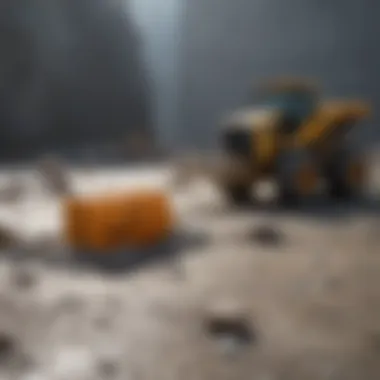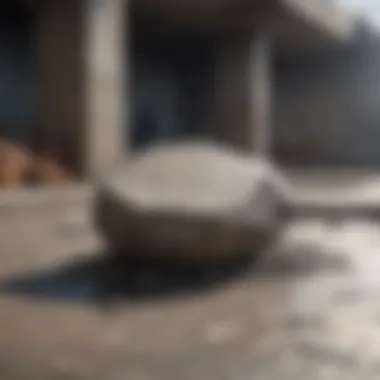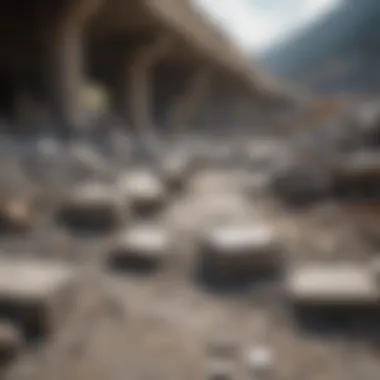Where to Dispose of Broken Up Concrete: Eco-Friendly Solutions


Overview of the Topic
Concrete disposal is an essential aspect of sustainable waste management, particularly concerning environmental impact. With the continual expansion of urban areas and construction projects, the need for responsible concrete disposal is paramount to mitigate ecological harm and promote resource efficiency. Understanding the various methods and locations for broken concrete disposal is crucial to reducing waste accumulation and fostering eco-friendly practices.
Current Status and Challenges
The current scenario of concrete disposal poses significant challenges to environmental conservation efforts. Improper disposal methods, such as landfills or unauthorized dumping, contribute to soil contamination, water pollution, and habitat destruction. These unsustainable practices not only endanger local ecosystems but also hinder the potential for concrete recycling and repurposing initiatives. Regulatory gaps and lack of public awareness further exacerbate the environmental challenges associated with concrete waste management.
Sustainable Solutions
Exploring sustainable solutions for dealing with broken up concrete is key to mitigating environmental impacts and promoting a circular economy. Recycling facilities and specialized disposal sites offer opportunities to process concrete debris efficiently, reducing the strain on natural resources and minimizing carbon emissions. Innovative technologies, such as crushing equipment and material separation techniques, enable the transformation of concrete waste into valuable resources for new construction projects or alternative applications. Public-private partnerships and community engagement play a crucial role in implementing sustainable concrete disposal practices and fostering a culture of environmental stewardship.
Impact and Importance
The impact of proper concrete disposal extends beyond waste reduction; it significantly contributes to preserving biodiversity, conserving natural resources, and enhancing environmental quality. By adopting eco-friendly concrete disposal methods, communities can safeguard ecosystems, mitigate greenhouse gas emissions, and support the transition towards a more sustainable future. Recognizing the importance of responsible waste management underscores the critical role individuals and organizations play in shaping a greener, healthier environment for present and future generations.
Introduction
In this expansive discourse on responsible concrete disposal methods, we delve into the significance of appropriately managing broken up concrete. The focus here lies on elucidating insights about the properties of concrete and the environmental repercussions of its disposal. Unraveling the layers of concrete debris management is crucial for promoting sustainable practices in the construction industry.
Understanding Concrete Debris
Properties of Concrete
Concrete, known for its exceptional durability and strength, plays a pivotal role in various construction projects. Its composition of cement, aggregates, and water results in a robust material capable of withstanding immense pressure and weathering. The unique amalgamation of these components makes concrete a preferred choice for structural integrity, highlighting its unparalleled resilience and longevity. Despite the advantages it offers in construction, the weight and density of concrete contribute significantly to the challenges of disposal and recycling efforts.
Environmental Impact of Concrete Disposal
The disposal of concrete debris presents a grave environmental challenge due to its volume and inert nature. Improper disposal can lead to land degradation, habitat destruction, and groundwater contamination. The accumulation of concrete waste in landfills contributes to greenhouse gas emissions and energy depletion through transportation. Implementing efficient waste management strategies is imperative to mitigate the adverse effects of concrete disposal on the environment.
Importance of Proper Disposal
Environmental Concerns
The environmental concerns surrounding concrete disposal revolve around the detrimental effects of improper waste management on ecosystems and natural resources. The inability of concrete to decompose naturally highlights the urgency of adopting sustainable disposal practices. Addressing these concerns involves implementing recycling initiatives and advocating for responsible waste management practices to safeguard the environment.


Legal Regulations
Legal regulations governing concrete disposal are essential for ensuring compliance with environmental standards and promoting sustainable construction practices. These regulations outline proper waste disposal protocols, recycling requirements, and permissible disposal sites. Adhering to legal guidelines not only minimizes environmental impact but also fosters a culture of accountability and eco-consciousness within the construction industry.
Recycling Options
As we delve into the realm of recycling options for broken up concrete, it is imperative to grasp the significance of this topic within the broader scope of sustainable waste management. Recycling not only aids in waste reduction but also mitigates environmental impact through resource conservation and energy efficiency. By exploring recycling avenues, individuals can actively contribute to environmental preservation while fostering a circular economy mindset.
Recycling Centers
Benefits of Concrete Recycling
The aspect of concrete recycling offers a multitude of benefits that align closely with the objectives of this article. Concrete recycling significantly reduces the demand for raw materials, thereby conserving natural resources and diminishing carbon emissions associated with traditional concrete production. This sustainable practice fosters a closed-loop system where waste is transformed into valuable material, promoting a more eco-conscious construction industry. The versatility of recycled concrete in various construction applications enhances its appeal as a viable and environmentally friendly solution for managing concrete debris.
How to Locate Recycling Centers
Locating recycling centers plays a pivotal role in facilitating the concrete recycling process effectively. By identifying nearby recycling facilities, individuals can easily transport their concrete waste for proper disposal and repurposing. Accessible recycling centers streamline the recycling workflow, encouraging widespread adoption of sustainable waste management practices. Understanding the operational hours, accepted materials, and guidelines of recycling centers ensures a seamless recycling experience, maximizing the environmental benefits of concrete recycling.
DIY Recycling Methods
Crushing Concrete for Reuse
Crushing concrete for reuse presents a practical and resource-efficient method of managing concrete debris. By breaking down concrete into smaller pieces, individuals can repurpose the material for road base, landscaping, or DIY construction projects. This cost-effective approach not only diverts concrete waste from landfills but also promotes self-sufficiency in handling construction materials. The process of crushing concrete empowers individuals to actively participate in sustainable waste management while exploring innovative ways to extend the lifecycle of this versatile material.
Creative Repurposing Ideas
Exploring creative repurposing ideas offers a unique avenue for reimagining the potential of concrete debris beyond conventional recycling methods. From crafting unique garden ornaments to designing outdoor furniture, the possibilities for creative repurposing are boundless. Embracing creativity in repurposing concrete waste not only adds aesthetic value to spaces but also showcases the transformative power of upcycling. By incorporating imaginative repurposing concepts, individuals can contribute to sustainable design practices and inspire others to view concrete debris as a valuable resource in the circular economy.
Disposal Locations
In the realm of responsible concrete waste management, the aspect of disposal locations holds paramount importance. Proper disposal of broken concrete is a critical step in minimizing environmental repercussions and facilitating sustainable practices. By understanding where to take broken up concrete, individuals can actively contribute to eco-friendly initiatives and reduce their carbon footprint. In this section, we delve into the significance of selecting the appropriate disposal locations, outlining key elements and considerations crucial for effective waste disposal.
Landfills vs. Transfer Stations
Pros and Cons of Landfills


Delving into the dichotomy between landfills and transfer stations provides valuable insights into the optimal disposal of concrete debris. Landfills serve as conventional waste disposal sites, offering a centralized location for dumping materials. While landfills provide a cost-effective and accessible option for concrete disposal, they pose environmental risks such as soil contamination and potential leaching of harmful substances into groundwater sources. On the contrary, transfer stations act as intermediary facilities where waste is temporarily held before transportation to landfills or recycling centers. Transfer stations offer the benefit of sorting and categorizing materials, enhancing the efficiency of waste management processes. However, reliance on transfer stations may lead to increased transportation costs and associated carbon emissions, highlighting the intricate balance between convenience and environmental impact in waste disposal practices.
Advantages of Using Transfer Stations
The utilization of transfer stations in handling broken up concrete presents various advantages that align with sustainable waste management objectives. Transfer stations streamline the waste sorting process, allowing for efficient segregation of materials and diversion of recyclable components from landfill-bound waste. By incorporating transfer stations into the waste management infrastructure, communities can enhance recycling rates and reduce the volume of waste destined for landfills. Additionally, transfer stations serve as hubs for community engagement, raising awareness about responsible waste disposal practices and fostering a culture of environmental stewardship. The accessibility and versatility of transfer stations make them a valuable asset in promoting sustainable waste management approaches, demonstrating the fusion of convenience and eco-consciousness in modern disposal strategies.
Local Disposal Facilities
Searching for Nearby Options
Navigating the landscape of local disposal facilities offers individuals a practical solution for handling broken concrete in an environmentally conscious manner. Identifying nearby disposal facilities streamlines the waste disposal process, minimizing transportation-related emissions and promoting efficient waste management practices. Local disposal facilities provide a convenient outlet for residents to responsibly discard concrete debris while supporting local waste management initiatives. By leveraging proximity to disposal facilities, individuals can reduce the environmental impact of concrete disposal and contribute to the sustainability of their immediate community.
Permit Requirements
Understanding the permit requirements associated with local disposal facilities is essential for ensuring compliance with regulations and fostering responsible waste disposal practices. Permit regulations govern the type and volume of waste accepted at disposal sites, mitigating potential environmental hazards and ensuring the safe handling of hazardous materials. By adhering to permit requirements, individuals can prevent illegal dumping activities and uphold environmental standards in waste management. Acquiring the necessary permits for concrete disposal signifies a commitment to environmental accountability and reinforces the adherence to legal frameworks governing waste management practices. Embedding permit compliance into waste disposal processes underscores the intersection of regulatory diligence and environmental consciousness in promoting sustainable waste management initiatives.
Environmental Impact
In this section, we delve deep into the critical aspect of environmental impact concerning the disposal of broken up concrete. Understanding the significance of mitigating adverse effects on the environment is paramount in today's eco-conscious world. By properly addressing environmental impact, we contribute to a cleaner and more sustainable future. Analyzing the lifecycle of concrete debris sheds light on the various stages where environmental considerations play a pivotal role. From extraction to disposal, each step can leave a footprint on the surroundings, hence emphasizing the necessity of responsible practices. Recognizing how concrete disposal can affect soil quality, water systems, and air pollution underscores the urgency of environmentally friendly approaches.
Reducing Carbon Footprint
Emission Reduction Strategies
When delving into emission reduction strategies, one encounters a host of innovative techniques aimed at curbing harmful gases released during concrete disposal. Implementing efficient transportation methods to reduce carbon emissions from hauling concrete waste is a crucial step in minimizing the overall carbon footprint. Utilizing state-of-the-art equipment that promotes cleaner combustion and energy-efficient operations further enhances the reduction of harmful emissions. These strategies not only decrease environmental impact but also lead to cost savings and operational efficiencies. Assessing the long-term benefits of emission reduction strategies highlights their integral role in sustainable waste management practices. The push towards greener alternatives aligns with a broader ethos of environmental responsibility, paving the way for a more eco-friendly future.
Energy Efficiency Initiatives
Energy efficiency initiatives encompass a spectrum of measures designed to optimize energy consumption during concrete disposal processes. By harnessing renewable energy sources to power crushing and recycling equipment, significant reductions in overall energy consumption can be achieved. The integration of smart technologies that streamline operations and minimize energy wastage also contributes to enhancing energy efficiency. Moreover, promoting a culture of energy conservation within disposal facilities fosters sustainability and reduces the environmental impact of concrete debris. Carving a path towards sustainability through energy-efficient practices not only benefits the environment but also establishes a foundation for long-term resource management strategies.
Conservation Efforts
Promoting Sustainability
At the core of promoting sustainability lies a commitment to fostering practices that uphold the delicate balance between economic development and environmental preservation. Encouraging the use of recycled aggregates in construction projects reduces the demand for natural resources, thus conserving valuable materials and minimizing ecological disruption. Embracing sustainable building practices that prioritize resource efficiency and waste reduction contributes significantly to environmental conservation efforts. The shift towards greener construction methodologies underscores the collective responsibility to safeguard our planet for future generations.


Community Involvement
Community involvement plays a pivotal role in driving environmental conservation efforts forward. Engaging local communities in waste management initiatives cultivates a sense of ownership and responsibility towards environmental protection. Encouraging participation in clean-up drives and recycling programs instills a culture of sustainability within neighborhoods. Furthermore, fostering partnerships between businesses, residents, and local authorities amplifies the impact of conservation efforts and fortifies communal ties. By empowering communities to take an active role in environmental stewardship, we pave the way for a greener, more harmonious future.
Innovative Repurposing Ideas
In the realm of repurposing concrete debris, innovative ideas emerge as a key aspect of sustainable waste management practices. These ideas not only reduce the environmental impact but also pave the way for creativity and resourcefulness. In this section, we delve deep into the significance of Innovative Repurposing Ideas, exploring specific elements, benefits, and considerations that play a crucial role in transforming broken concrete into valuable assets.
Artistic Installations
Sculptures and Land Art
Sculptures and Land Art stand out as a captivating facet of repurposing concrete debris. Their contribution to the overarching goal of sustainable waste management lies in their ability to blend artistry with environmental consciousness. Sculptures and Land Art showcase a remarkable harmony between man-made structures and natural landscapes, creating a mesmerizing visual impact while promoting eco-friendliness. The durability and aesthetic appeal of Sculptures and Land Art make them a popular choice for projects aiming to repurpose concrete debris. Their unique feature of integrating art into public spaces enriches the environment, although their maintenance and installation can present challenges in certain contexts.
Mosaic Creations
In the realm of Innovative Repurposing Ideas, Mosaic Creations offer a distinct approach to transforming broken concrete into intricate artworks. The key characteristic of Mosaic Creations lies in their ability to repurpose concrete debris into colorful and elaborate designs, adding a touch of sophistication to various settings. This makes Mosaic Creations a beneficial choice for projects seeking to infuse personality and charm into repurposed materials. The unique feature of Mosaic Creations lies in their adaptability to different surfaces and structures, allowing for creative freedom in revamping spaces. While Mosaic Creations enhance aesthetics and foster sustainability, their labor-intensive nature and meticulous detailing can pose challenges in large-scale applications.
Ongoing Projects
City Beautification Initiatives
Within the domain of ongoing projects, City Beautification Initiatives play a vital role in transforming urban spaces with repurposed concrete elements. Their contribution to the overall objective of sustainable waste management manifests in the revitalization of city aesthetics through eco-friendly practices. City Beautification Initiatives emphasize the integration of green spaces, public art, and sustainable materials, enhancing the quality of urban life while mitigating environmental impact. The key characteristic of City Beautification Initiatives lies in their ability to engage communities and foster a sense of pride in local surroundings. This makes them a popular choice for initiatives focused on promoting sustainability and enhancing urban aesthetics. The unique feature of City Beautification Initiatives lies in their long-term positive impact on community well-being, although securing funding and ensuring stakeholder engagement can present challenges in their execution.
Public Infrastructure Development
Aiming to advance infrastructural sustainability, Public Infrastructure Development projects leverage repurposed concrete materials to enhance public amenities and utilities. Their contribution to the overarching goal of sustainable waste management involves optimizing resource utilization while improving civic infrastructure. Public Infrastructure Development initiatives prioritize durability, functionality, and environmental responsibility, making them a preferred choice for projects seeking long-term sustainability benefits. The key characteristic of Public Infrastructure Development lies in their emphasis on enhancing public services and facilities through eco-conscious practices. This distinguishes them as valuable assets in promoting environmental stewardship and urban resilience. The unique feature of Public Infrastructure Development lies in their capacity to integrate innovative solutions with traditional infrastructure, although balancing cost considerations and regulatory compliance can pose challenges during implementation.
Conclusion
In this final section, we delve deep into the essence of sustainable concrete disposal. This topic holds immense significance in the broader context of environmental responsibility. By embracing eco-friendly practices in dealing with broken concrete, individuals and communities can contribute significantly to reducing their carbon footprint and preserving natural resources. The relevance of this Conclusion lies in its call to action for implementing responsible waste management strategies that prioritize sustainability. By understanding the environmental impact of concrete disposal and the importance of proper waste handling, readers can make informed decisions that promote a greener future for generations to come.
Embracing Sustainable Practices
Call to Action for Eco-Friendly Disposal
Exploring the specific facet of adopting eco-friendly disposal methods, we emphasize the pivotal role of a Call to Action for Eco-Friendly Disposal in cementing sustainable practices. This element serves as a catalyst for instigating change towards environmentally conscious behaviors. The primary characteristic of this call to action lies in its emphasis on promoting awareness and encouraging proactive steps towards reducing environmental harm. By advocating for the adoption of eco-friendly disposal techniques, this aspect aligns with the overarching goal of the article, which is to cultivate a mindset of environmental stewardship among readers. Despite some challenges, the advantages of this eco-friendly disposal approach in the context of this article are evident, as it stimulates a sense of responsibility and instills a culture of sustainability.
Contributing to a Greener Future
Delving into the concept of Contributing to a Greener Future, we unravel its profound impact on the overarching theme of environmental conservation. This aspect showcases a dedication to long-term sustainability goals that extend beyond immediate benefits. The fundamental characteristic of this initiative is its proactive approach to addressing present environmental challenges through strategic planning and thoughtful interventions. By advocating for practices that foster conservation and sustainable development, this aspect aligns with the core values of the article, emphasizing the importance of forward-thinking solutions in mitigating ecological harm. The unique feature of Contributing to a Greener Future lies in its ability to inspire collective action and drive positive change at various levels. While there may be obstacles to overcome, the advantages of this forward-looking approach in the context of this article are undeniable, as it paves the way for a more ecologically responsible and harmonious future.



